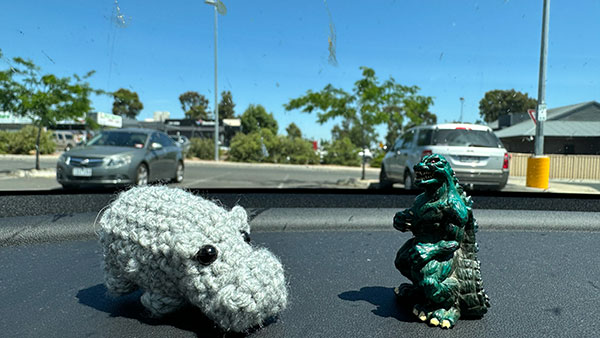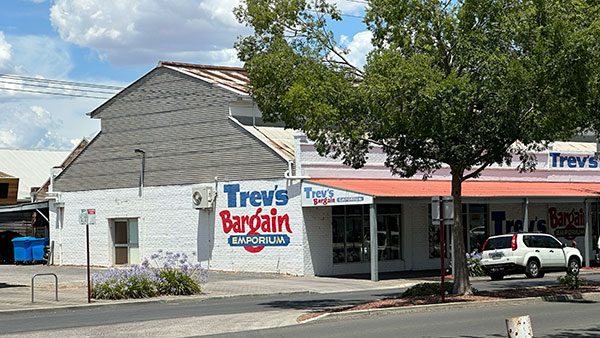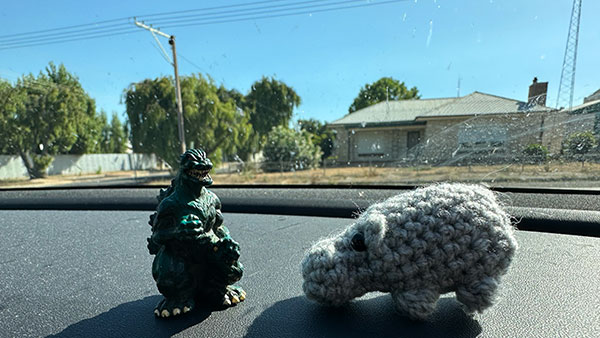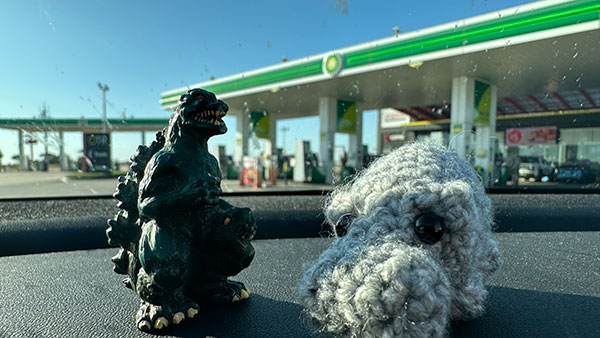Heading west, dealing with charger availability, fatigure and flooding. Will our heroes make it to Adelaide? (Spoiler: Yes. Eventually).
This is the second part of my writeup of a recent trip made from Sydney to Adelaide in an EV in very early 2023, as a way of showing what’s possible, what you need to think about, and what can go wrong (or weird) along the way.
Day Two, Stop Two: Tesla SuperCharger, Bendigo

The odd not-charged-money-but-actually-charged Euroa stop over, we started to head properly west, along a road that (as far as I can tell, feel free to correct me) would basically be the quicker way to do Melbourne to Adelaide as well, once you’d headed north out of Victoria’s fine capital city.
That meant the next stop was in Bendigo, where there’s a set of six Tesla superchargers that we opted to use.
Although as stops on the way go, Bendigo’s got quite a few options in chargers, including a dual Evie charger at the Art Gallery and a few slower chargers in retail locations.
The reason for using the Tesla chargers here was largely because it was still peak holiday time – 1st of January, in fact – and the day was getting on and we were aware that there was some possibility for wait times for chargers.
One of the details you do have to wrap your head around with these longer EV drives is that it can be a more leisurely affair for sure (and that can have big benefits in terms of seeing the sights and such, as well as taking healthy rest breaks from driving), but because we knew we still had a long drive to go, getting going sooner was hugely preferable.
This charger’s oddity: The Tesla chargers in Bendigo are located in an open air shopping centre carpark – and they’re arguably the best laid out chargers (or possibly equal best) of all the sets of multiple chargers we used across the entire journey.
Why? Because there’s six chargers back to back, which means you don’t have a long line of cars, or a big block to the rest of the carpark as cars negotiate reversing in or driving out.
The chargers aren’t super close to the shopping centre as well, and I’m cool with that – it minimises the likelihood that they’ll be used as “regular” parks by ICE vehicles.
In any case, there was literally just enough time to walk up to the shops and hit the bathrooms before the car was ready to hit the road again. Or in other words, a regular toilet break in a regular car would have taken exactly as long.
Day Two: Stop Three, St Arnaud
This wasn’t a charging stop to speak of, but instead a calculated play built around having two drivers and managing fatigue levels.
This is an important factor not only in EV driving, but in driving generally. One of the most common arguments I see from the anti-EV crowd runs something like this…
“EVs are useless because I can do 1,000km in my car without stopping. They won’t be any good until I can do that.”
This is really, truly stupid thinking.
Not so much on the physics or recharging side of the ledger to speak of, but instead on the safe driving side of it.
Is it physically possible to drive for 10 hours straight without stopping? Yes, it can be done.
Should you do that? Hell no.
I’ll go further than that. If you think that it’s a sign of how you’re a superior driver, you’re flat out wrong.
You’re driving in a dangerous way, and every single study and stat backs me up on that. Fatigue kills, end of story.
I don’t care what’s driving your engine, if you’re not prepared to schedule breaks and take them, then you’re driving in an irresponsible way.
The crash you have won’t just affect you – and could turn you into a murderer.
And if you think a statement like that makes me a judgemental prick, I’m 100% fine with that. You can have your opinion, and I’ll continue to champion actual safe driving.
Day Two, Stop Four: Tesla Supercharger, Horsham

Heading further west, we were getting into some serious driving hours for the day. I can very much see some folks taking this as a three day drive, and that’s not a bad idea if you can manage that much time. We didn’t quite have that much time to speak of, and in fact had a call from the place we were staying at in Adelaide to ask what our likely arrival time was.
At that point it looked like it’d be around 8pm or so that night. Eep.
This charger’s oddity: Horsham has three chargers at the side of a shopping centre, not too tricky to get into… if it’s not too busy.
I have (so far) lived a slightly charmed life of charging, because while EVs are slowly ticking up in numbers in Australia, I’ve not had to queue for a charger to date.
Horsham came very, very close to changing that. There was one charger in use when we arrived, so we grabbed the other side one – the traditional setup for most being that they’re paired somehow, and while I don’t know how that works for a set of three, not being right beside the in-use charger feels like it makes the most sense – and got to charging. About a minute later, a third car arrives and starts charging.
All well and good – we don’t need more than one charger at any one time – but then a minute later another Tesla shows up. A couple of minutes delay on the road somewhere, and that would have been us.
Or the Tesla that showed up a minute after that. Or the one a minute after that again. It started to feel a touch odd, because before we’d finished our 20 minutes of charging needed, there was a queue of no less than five cars waiting to charge.
It does really point to the need for more infrastructure in areas like this, because while they won’t be in use all of the time, at peak times there’s a clear need – and, for that matter, something of an emerging business case.
We certainly didn’t dawdle at the charger (in keeping with Wheaton’s law) and hit the road again.
Day Two, Stop Five: Nhillball Wizard
Nhill is a tiny town, and one that doesn’t have any specific EV charging infrastructure, but it made a good nearly-halfway break point to swap drivers on the way to Keith.
Correction: It made a great stop, one that I’d recommend anyone take between the hours of 11am and 9pm.
Why those times? Here’s why:
Day Two, Stop Six: Tesla Superchargers, Keith

I’ve oddly wanted to visit Keith for years, mainly because of an old school friend of mine. No, he’s not from there. He’s just called Keith.
Yes, that’s the most facile reason to want to visit a place possible, but there you go.
With the experience of Horsham and its very busy chargers fresh in my mind, I had serious concerns about charger availability.
Thankfully this wasn’t the case, and I’m going to argue that the 30 minute stop in Nhill to play pinball may have played a role there. The lesson is clear here: If you have the opportunity for a pinball break, take it.
This charger’s oddity: Keith’s Superchargers have two oddities that I noted.
Firstly, they’re arguably the lesser option in town in terms of convenient facilities nearby, because there’s a set of Chargefox chargers at the petrol station before you come to them.
I didn’t notice those until I thought to check Plugshare on the day, though. Comparatively while there are bathrooms nearby, being as it was a public holiday there was nothing else to do while the electrons trickled into Carhausen.
Pro tip: Pack a thermos of coffee for times like this.
Also, while there are four Tesla chargers in Keith, they’re in an odd 3 straight, one side on configuration.
The sideways one is a little easier to park in if you’re approaching it, and I presume that it’s there so that those with trailers can just pull in…. except that in that case it wouldn’t be long enough, and your trailer would block the other three chargers from entry or exit.
Yes, you can tow things in an EV, let’s not go there, OK? But the complexities around charging and towed trailers or caravans is a complex layout matter. I’m not sure that the Keith solution fixes this… or am I missing something?
I’d be quite cranky if I was charging my car and a trailer pulled in and stopped me leaving. I don’t think I’d be in the wrong being annoyed by that either.
Day Two, Stop Seven: Tesla Superchargers, Tailem Bend

It’s worth noting that at this point, I could have made it all the way to Adelaide with a little power to spare, and that’s on the basic model 3 vehicle, not the long range.
But still, I stopped at Tailem Bend.
Why?
This was largely a tactical move, because while my research suggested that Adelaide had a few different options when it came to chargers, I also knew that I was pretty darned tired and didn’t entirely relish having to drive around the next day to work out which were operational, or in use, or whatever.
The prospect of having a car with a solid tank of electrons was more compelling, especially as we’d arranged late motel access already.
Tailem Bend has a bank of six chargers at the side of one of those huge roadhouses anyway, and alongside Bendigo it’s one of the easiest to use across the entire drive.
So we stopped there to recharge the car and buy a slightly sloppy burger for dinner. Again, you can judge me separately on my food choices if you must.
This charger’s oddity: The Tailem Bend superchargers are up to 250kW, but the model 3 (or at least the base model I’ve got) can (as far as my research suggests) maxes out at 170kW, so it can’t quite push these chargers the fastest.
That does vary by model, and it’ll be interesting to see how that works out as and when Tesla opens up its network.
Which… brings me back to Tesla. The Tailem Bend model, using the existing large land area around existing large service stations seems like such an obvious win-win play on every level.
As a small aside, I copped some flak from the Elon Musk fans in my writeup of part one for daring to not view the man in anything but the most glowing terms in part one of this writeup.
To which I’ll say that it’s my view (and my blog), I don’t get at all the near deification that some try to put on him. He’s certainly a divisive figure at best.
But in terms of the supercharger access story, I 100% back the idea of opening them up as wide as feasible as fast as feasible.
Does that mean I’m more likely to have to wait for a charger?
Yeah, that seems probable. But the reality there is that it’d do just as much if not more to accelerate the uptake of EVs in Australia (a net good) by reducing the long drive charger anxiety issues.
Tesla could differentiate pricing based on whether you were in-house or not (it’s still their infrastructure, after all, and it’d keep a financial advantage to buying their cars), and it’d keep competition flowing in the EV charging space. I think we’re going to need that competition across the entire EV field.
Day Two, Stop Eight: Adelaide
We had flooding concerns around Murray Bridge, but while it was quite obvious the river banks were up, we were (thankfully) able to pass through without incident. Obviously terribly stressful and difficult for the locals, and a reminder that it’s a bad idea to be a disaster tourist — but a great choice to visit places that are rebuilding, because that’s precisely when they need the custom.
And finally, at around 8:30pm that night, taking into account the time zone shift, we arrived in Adelaide.
We’d started the day at 5am on the road in Wagga Wagga, and this was a long drive… and it did feel good to be done.
I think that’s enough for this part. I drove it, and it’s exhausting enough just writing it up!


